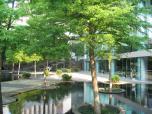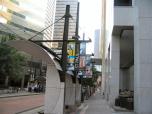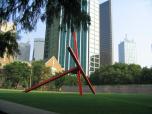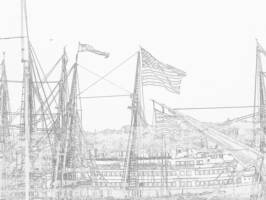




It is amazing how some things go full circle in just a few decades and, with changing tastes, over the past fifteen years, the town square has risen in popularity as a development to gather people together even as they are being encouraged to move into communities that surround them. Rural, exurban, suburban, and smack in the central city, developments have risen from the ground that can function as authentic community centers. In the Dallas area, West Village has been quite successful in promoting the neighborhood feel for those who live there and nearby, and is a draw for residents from other parts of town due to its vibe. The Bishop Arts District is an example of re-doing old construction in the middle of a historic area. On the high end, Highland Park Village, the second oldest shopping center in the United States, can draw the community crowds for annual events such as Christmas tree lightings. Consider also, Legacy Town Center in Plano, Addison Circle, Downtown Carrollton, Southlake Town Square, Main Street in Grapevine, and a long list of other squares and centers in North Texas, and the concept is well represented here.
What did an early American town center look like though? Let’s consider 18th Century Charleston, or as it was called then, “Charles Town”, South Carolina, before the American Revolution. Some called this a beautiful city of brick and wood. In the middle of town stood several churches, a prominent French Protestant one, as well as several dissenting congregations. The streets and houses are described as being in good condition and regularly built. In 1765, Charles Town had 1,000 houses and 8 churches. The pedestrian-ways of the major streets were paved in brick. In the center of town there was a considerable State House and a substantial library. The steeple of St. Michael’s church was the highest in town and commanded a fine view of the town, harbor, river, forts, and sea.
In the 1730’s the area within its defensive walls was approximately (.75) miles in length and (.25) miles in width. Buildings that a visitor to Charleston today would see which a visitor in 1770 would have seen include places such as:
• The Courthouse, built in 1735
The Courthouse, built in 1735
• St. Michael’s Church, first built as St. Philip’s Church in 1690, changing its name to St. Michael’s in 1762
St. Michael’s Church, first built as St. Philip’s Church in 1690, changing its name to St. Michael’s in 1762
• The Armory, built in 1750
The Armory, built in 1750
• The Watch House, built in 1767
The Watch House, built in 1767
• The Exchange, built in 1769
The Exchange, built in 1769
• The Council Chambers built in 1735
The Council Chambers built in 1735
• The Beef Market, built in 1735
The Beef Market, built in 1735
• The Town Marketplace, built in 1680
The Town Marketplace, built in 1680
• Archdale Square, built in 1683
Archdale Square, built in 1683
• The Dock Street Theater, built in 1736
The Dock Street Theater, built in 1736
• The Fish Market, (under construction in 1770)
The Fish Market, (under construction in 1770)
• The “New” Powder magazine, built in 1737
The “New” Powder magazine, built in 1737
• The “Old” Powder Magazine, built in 1712
The “Old” Powder Magazine, built in 1712
• The New Market Racetrack, built in 1760
The New Market Racetrack, built in 1760
• The Governor’s Bridge, built in 1767
The Governor’s Bridge, built in 1767
Charles Town was described by a visitor who sailed there from Philadelphia in the 1760’s; I have applied literary license to the description and changed names to protect the historically innocent, but here is how Charles Town or Charleston might have appeared.May 27, 1765 – I arrived in Charles Town yesterday after a long voyage from Philadelphia. After getting my rest and a decent night’s sleep, today was spent in viewing the town. From my observations, and what I have been told, this great city has about 1,000 houses. The inhabitants of this city include about 5,000 whites and 20,000 blacks. I can count eight churches from my walking today, the most prominent of which are St. Philip’s and St. Michael’s. I must say that these two churches were large stone buildings, very impressive actually, with two-story porticos with large pillars and steeples. St. Michael’s church is painted a brilliant white. All day today I could hear the magnificent sound of the bells of St. Michael’s. They have a good ring to them! Other churches I saw included a Scottish Presbyterian Church, one Independent church which was called the New England Meeting. I also passed by the Dutch church. Three other churches I saw that were actually quite small included two Baptist churches and a French church.
I was able to visit the State House and noticed that it is a very substantial building of about 120 feet by 40 feet. It is two-stories tall built with brick and covered with stucco. . The Council Chamber is about 40 feet square. It is decorated with grand weighty pillars and has a lot of carving. I would call it more of a superb rather than an elegant building. The assembly room is of roughly the same dimensions, and is a much plainer room.
In my walking today, I noticed that Charles Town’s streets run North-South and East-West, intersecting each other at right angles. The only parts of these streets that are paved are the foot ways which are about six feet wide. These are paved on the main streets.
In my walks today I saw the large fortifications that surround the town. However a large part of them is unfinished and in a state of ruin. I was impressed with Johnson’s Fort over on James Island. It is a pretty fort and commands the entrance to the harbor.
I was hot today. The climate is quite warm here, significantly warmer than what I am accustomed to in Pennsylvania. The people who I spoke with told me that the chief crops of this region are rice and indigo. They actually export about 100,000 barrels of rice annually and 60,000 pounds of indigo.
There are no considerable schools for advanced learning here in this region. I am told however that many of the youth of quality travel to London for an education. I like the people who I meet here. They are polite and affable and make a stranger such as myself feel right at ease with them.
My final notation for today concerns the library that I visited. It is well-stocked with over 5,000 volumes and a great number of magazines, including ones purchased from England that comprise the original collection in the Library. All of this is managed by the Charlestown Library Society.
May 29, 1765 – I must say the weather is quite warm here. It is probably too warm for my personal tastes, but I managed to continue to get around the town, exploring it the best I could. Before I left Philadelphia, I had been given a letter of introduction to a very kind and generous merchant here in Charleston, a Mr. William Tiff. He invited me into his fine home on the northern edge of the city, and we spent several hours dining together,
May 30, 1765 – I continue to be shown very kind and generous hospitality. Today I dined with a Mr. John Burke, a Scotch merchant in this city. Again, he was another very agreeable and polite man. I mentioned the whites and blacks who comprise the city, but I must add that there is such a diversity of cultures here from the substantial Jewish community here in the town, to various people from all over England and Scotland, the European continent, and even Jamaica and other areas of the Caribbean. There are also a fair number of Portuguese who have come here from all over.
June 3, 1765 – After a weekend where I enjoyed some rest and time of worship yesterday, I resumed my activities today having a very agreeable and pleasant afternoon dining with a Mr. Thomas Lipton and another gentleman of note, a Mr. Mindo, who is an inspector of indigo here. Our time was spent in Mr. Lipton’s summer house.
June 4, 1765 – Well, today was the King’s birthday, a glorious day and fabulous affair!. Charles Town showed that it knew how to celebrate by having all the men of the city show up under arms. Guns were fired at all of the forts. My observations of the artillery were that they made a good appearance and performed their exercises and firings with remarkable precision. I have to say that the militia were not so well trained and exercised, but made a pretty handsome appearance anyway.
June 8, 1765 – I must say that I was quite depressed today. The sale of my flour did not go well and I am afraid I will be leaving Charles Town and going home to Philadelphia with a loss on the books. The day was made better in the afternoon though when I went to dine with Mr. Lipton in his summer home, staying with him until 5:00 in the afternoon. Then, in order to get some perspective on Charles Town and on my business trip here, I went to St. Michael’s church and climbed up into its steeple which is the highest in town. From there I had a commanding view of everything: the town, river, harbor, forts, sea and everything else. The rooftops of this town lend themselves to an impression of substance in every way. Charles Town truly is a pleasant place and I have enjoyed my time here, despite my disappointment earlier today.
June 11, 1765 – I have to say that today I had much better luck in the sale of my flour. Mr. Lipton has been a great gentlemen and friend to me during my stay here in Charles Town. He managed to procure for me a sale of four pounds per container of flour. I am now in much better financial condition to return to Philadelphia next week. After this business transaction I dined with him and Captain Crain from England, and Mr. Mead. After a very agreeable afternoon with them in Mr. Lipton’s summer home, I spent a very enjoyable evening with the Reverend Robert Simms. He is an interesting man who came over recently from Scotland. He has had much sadness in his life, but has managed to overcome that with a cheerful and giving disposition.
June 12, 1765 – Most of today I spent getting my business accounts in order for my return journey and exchanged my money into dollars. The air was quite sultry, although it was cooled by frequent rain showers and gusts of wind. I relaxed at Mr. Lipton’s summer home for a while, enjoying the view of Johnson’s Fort in the distance. I must make a plan to get over there to see it up close before I leave.
June 13, 1765 – I saw the most incredible thing today that I have heard about in New England, but simply had not seen. I saw an alligator today! Actually I understand that there are many in the rivers and bays in this country. This one was about three feet long and three inches in diameter. He had very scaly skin, much like a snake, with a very large and cavernous mouth with irregular long teeth, somewhat similar to a fish, somewhat to a dog. They tell me some of these animals are 15 or 18 feet long.
June 14, 1765 – Mr. Lipton took me by boat to Sullivan’s island where there were several hundred quarantined due to the smallpox. It was quite sad to see the poor accommodations for many of them, particularly for a poor man in a boat about ten rods from shore. It was a hot and sultry day today. I just really felt for those poor people.
June 15, 1765 – Today was a bit better weather-wise, but still warm and sultry. Mr. Lipton and I dined together and then I took my leave to walk to the library. Later on this afternoon I spent time in town near the docks with some Guinea captains who I must say are a rough sort of people, but are somewhat taken care of by the merchants here. In the evening I walked down by the water, and then smoked a pipe at Mr. Glen’s.
June 16, 1765 – This morning I attended church services at the Scotch Presbyterian Church. The Reverend Howell preached. I then dined with Mr. Glen and various other gentlemen, including a Mr. Niche. This evening I attended services at the New England Independent Church before having a walk with gentlemen from Jamaica who has just arrived. Later on I went back to Mr. Glen’s and we had a very fine evening.
June 18, 1765 – Today was the day that I left Charles Town and all of my acquaintances and friends whom I have made. My final thoughts are that it is a very agreeable and polite place where I was treated very genteelly and made a number of acquaintances. The heat is sultry, quite oppressive. The water is bad, the soil is too sandy and there is too much evergreen around. All in all however, it is quite a flourishing place that is capable of much growth and enhancement. I worry though about its distance from proper authority and how long it will be before the bandits really come against it in all force.
About this same time, another visitor to Charles Town, had a slightly different view of the city. The gentleman, a captain of a British warship in 1769 states it this way:
Black and white all mix’d together,
Inconstant, strange, unhealthful weather
Burning heat and chilling cold
Dangerous both to young and old
Boisterous winds and heavy rains
Fevers and rheumatic pains
Agues plenty without doubt
Sores, boils, the prickling heat and gout
Musquitos on the skin make blotches
Centipedes and large cock-roaches
Frightful creatures in the waters
Porpoises, sharks and alligators
Houses built on barren land
No lamps or lights, but streets of sand
Pleasant walks, if you can find ’em
Scandalous tongues, if any mind ’em
The markets dear and little money
Large potatoes, sweet as honey
Water bad, past all drinking
Men and women without thinking
Every thing at a high price
But rum, hominy and rice
Many a widow not unwilling
Many a beau not worth a shilling
Many a bargain, if you strike it,
This is Charles-town, how do you like it.
By Capt. Martin, captain of a Man of War.
In all summation, history is a wonderful thing. Historical methods of community development lend to great interaction among citizens of the city. The romance of the past can also blind one’s eye to the not so pristine, the all too often lack of well-being, and the realization that yes, bandits existed even in the good ole days, and were often ready to plunder from just beyond the gates. I believe now after writing this piece and learning a bit more about Charleston or “Charles Town”, I might just be ready to embark on a voyage there to decide for myself, “This is Charleston. How do I like it?”
Rose-colored Romance with the Past
Posted: October 7, 2012 by Chuck DeShazo
Articles
Rose-colored Romance with the Past
